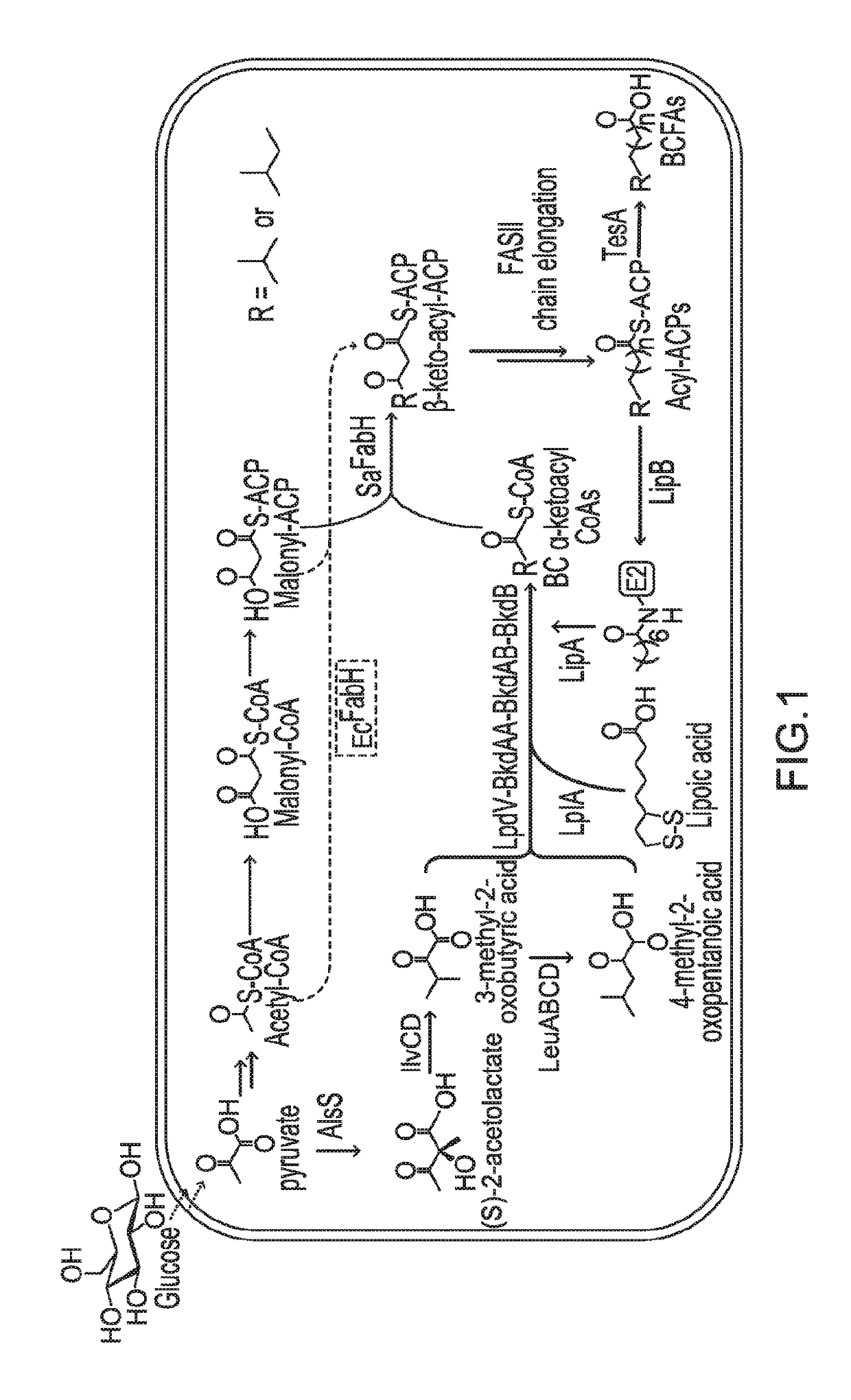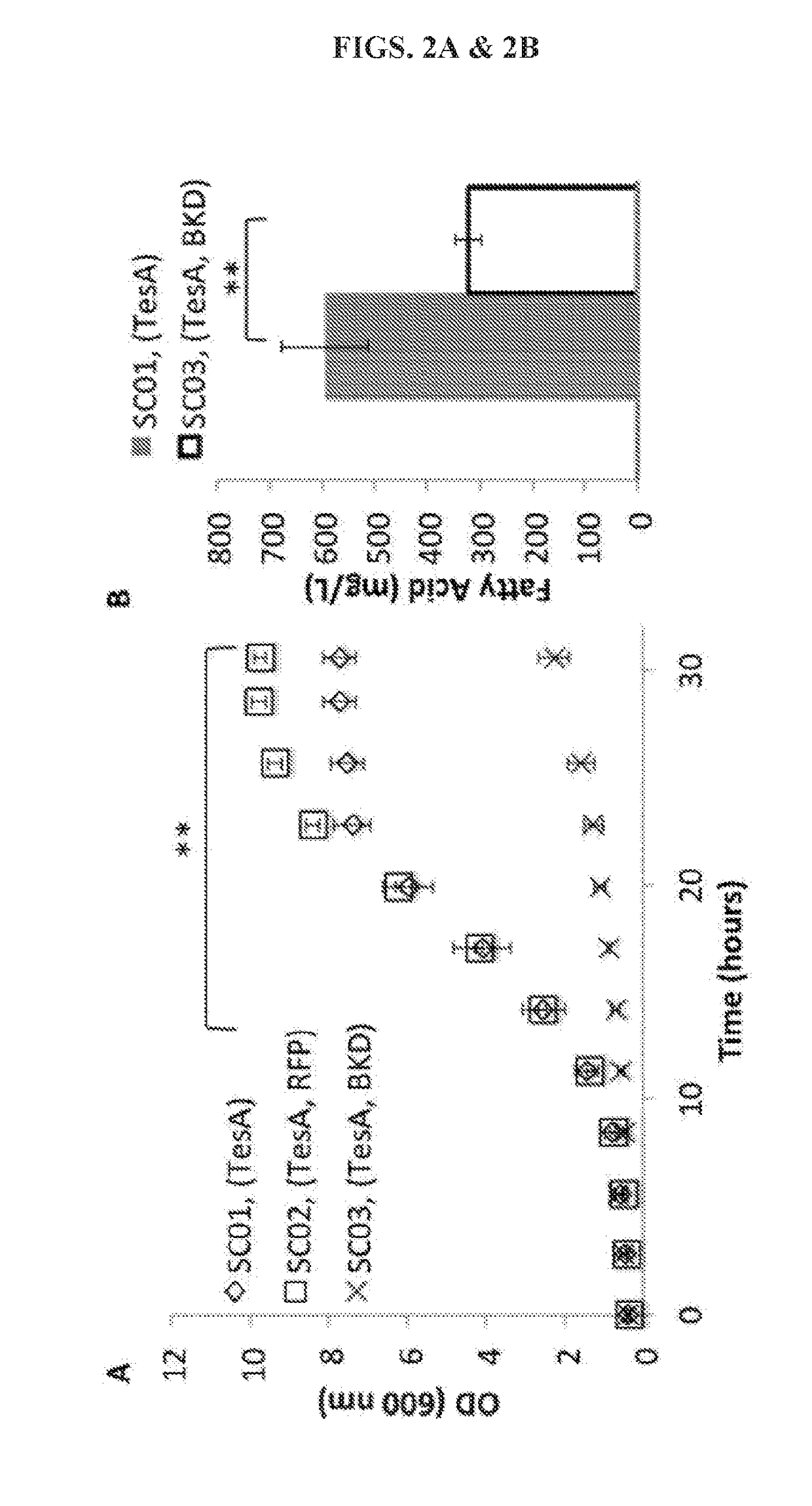Host cells and methods for producing fatty acid-derivatives with high branched-chain percentage
a technology of fatty acid derivatives and host cells, applied in the field of transformed host cells, can solve the problems of difficult separation and physical-chemical properties, and achieve the effect of high titer and high percentag
- Summary
- Abstract
- Description
- Claims
- Application Information
AI Technical Summary
Benefits of technology
Problems solved by technology
Method used
Image
Examples
example 1
[0109]In this Example, the impact of BKD on cellular lipoylation was analyzed.
[0110]A FFA-overproducing strain, SC01 (Tables 1 and 2), was first constructed by overexpressing a cytosolic thioesterase (TesA) in a fadE deleted E. coli DH1 strain. Next the Bacillus subtilis BKD was introduced to strain SC01, resulting in strain SC03. Overexpression of BKD significantly reduced cell growth when compared to strain SC01, p<0.01 (FIG. 2A). Expression of a red fluorescent protein (RFP, strain SC02) did not affect cell growth, indicating that the impaired cell growth was likely not caused by metabolic burden from protein expression. When strains SC01 and SC03 were cultivated for FFA production, a significant reduction in total FFA occurred with BKD overexpression, indicating that BKD expression also inhibits total FFA production (FIG. 2B).
[0111]Overexpression of the PDH E2 subunit in E. coli represses PDH activity, suggesting that E. coli has limited protein lipoylation capacity. Expression ...
example 2
[0113]In this Example, the LplA was expressed for analyzing its effect on BCFA production.
[0114]The protein lipoylation deficiency caused by BKD overexpression was overcome by engineering a protein lipoylation pathway. E. coli utilizes two pathways for protein lipoylation (FIG. 3A). The first pathway synthesizes lipoate de novo, for which an octanoyl-moiety from octanoyl-ACP is transferred to an E2 subunit by LipB, followed by insertion of two sulfur atoms into the octanoyl side chain of an octanolyated E2 domain by LipA, forming a five membered ring. Alternatively, exogenous lipoic acid can be ligated directly to an E2 subunit by lipoyl protein ligase A (LplA, encoded by lplA). A strain was engineered to utilize exogenous lipoic acid, in order to maximize the amount of octanoyl-ACP available for fatty acid elongation. lplA under the control of a PBAD promoter was cloned and transformed to the previously-described BCFA-producing strain, BC11A (CL111 (plsX′fabH; aadA)::TetA pSa-PEcfa...
example 3
[0116]In this Example, the expression of SaFabH was analyzed for improvement of BCFA production.
[0117]Whether the engineered lipoylation pathway would further increase BCFA production in a SaFabH-containing strain was tested. Strain BC13L was constructed expressing LplA in strain BC13A, which contains SaFabH as the sole FabH. While BC13A produced 120 mg / L BCFA, corresponding to 52% of total FFA, BC13L produced 494 mg / L BCFA, representing 79% of total FFA produced under the same cultivation conditions (FIG. 4C). The predominant product was 13-methyltetradecanoic acid (C15 iso, 318 mg / L), representing 50% of total FFAs. These results demonstrated that the engineered E. coli produced BCFAs in high titers (up to 494 mg / L) and high percentage (up to ˜80%). Significantly, the results also demonstrated the high percentage BCFA production in E. coli, which would be difficult if high proportions of BCFA restricted SCFA availability for membrane construction.
PUM
| Property | Measurement | Unit |
|---|---|---|
| Fraction | aaaaa | aaaaa |
| Fraction | aaaaa | aaaaa |
| Volume | aaaaa | aaaaa |
Abstract
Description
Claims
Application Information
 Login to View More
Login to View More - R&D
- Intellectual Property
- Life Sciences
- Materials
- Tech Scout
- Unparalleled Data Quality
- Higher Quality Content
- 60% Fewer Hallucinations
Browse by: Latest US Patents, China's latest patents, Technical Efficacy Thesaurus, Application Domain, Technology Topic, Popular Technical Reports.
© 2025 PatSnap. All rights reserved.Legal|Privacy policy|Modern Slavery Act Transparency Statement|Sitemap|About US| Contact US: help@patsnap.com



